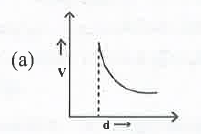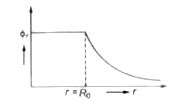ஒரு உள்ளீடற்ற உருளை வடிவ தகட்டின் மின்னழுத்தம் V, தொலைவு (r) ஐப் பொறுத்து மையத்திலிருந்து மாறுகிறது. இதற்கான வரைபடம். [V_(உள்ளே) = Q/(4piepsilon_(0)R) r le R, V_(வெளியே) = Q/(4piepsilon_(0)r) r ge R, V alpha 1/r]




The correct Answer is:B
Similar Questions
As shown in the figure, the symmetrical spherical body is at the origin, its constant electric potential. (phi_(r)) has given. phi _(r) = (q)/(4pi epsi _(0)) (r ge R _(0)) And phi_(r) =(q)/(4pi epsi _(0) R_(0)) (r le R _(0)) Then the following statement will be false.
View Solutionसममित गोलीय आवेश वितरण के लिए वैद्युत विभव का केन्द्र से दूरी के साथ परिवर्तन चित्र में प्रदर्शित है। दिया है ϕr=q4πε0r,(r≥R0) के लिए ϕr=q4πε0r,(r≤R0) के लिए कौन-से विकल्प सही है?

View Solutionरेखीय (p−q)x+(q−r)y+(r−p)=0
(q−r)x+(r−p)y+(p−q)=0
व (r−p)x+(p−q)y+(q−r)=0 है
View SolutionThe lines (p-q)x+(q-r)y+(r-p)=0(q-r)x+(r-p)y+(p-q)=0 (r-p)x+(p-q)y+(q-r)=0
View Solution[[ 0 , p-q , p-r ],[q-p , 0 , q-r],[ r-p , r-q , 0 ]] =
View SolutionIf p,q,r are not in geometric progression and ∣∣ ∣ ∣∣1qpα+qp1rqα+rqpα+qqα+r0∣∣ ∣ ∣∣=0 then prove that pα2+2qα2+r=0
View SolutionWhich of the following is not equivalent to (p∧~q)→r
(a) ~(qv~p)→r
(b) ~r→(~pvq)
(c)~((p∧(~q))∧(~r))
(d) ~r→(~p∧q)
View SolutionWithout expanding the determinant prove that: ∣(0,p−q,p−r),(q−p,0,q−r),(r−p,r−q,0)|}=0
View Solution

